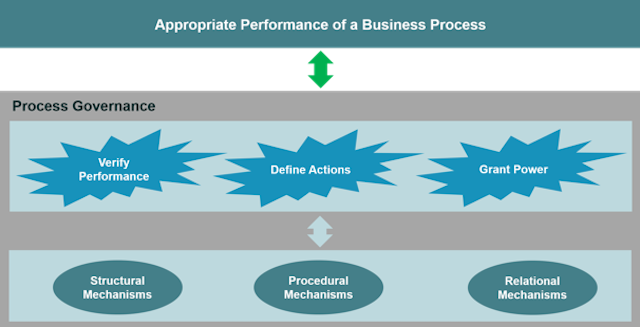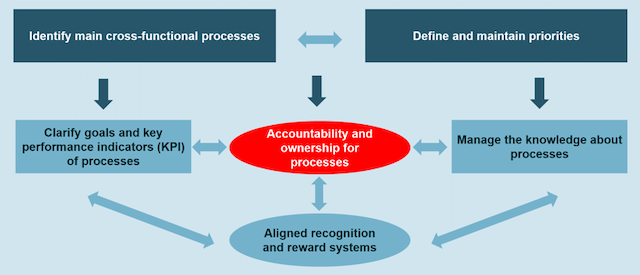The Impact of Digital Transformation on Process Governance
Most companies have launched digital transformation initiatives (Kirchmer, Franz, Lotterer, Antonucci, Laengle, 2016). Hyper-Automation has become a reality which changes the way business processes are organized and executed (Stoudt-Hansen, et al., 2019). However, only a small number of organizations have their business processes sufficiently under control to realize the full potential of new digital technologies (Kirchmer, 2019) (Cantara, 2015). Appropriate business process management (BPM) capabilities have a significant impact on the value achieved through digitalization (Antonucci, et al., 2020).
This is especially true for establishing appropriate business process governance. Process governance drives the realization of the targeted digitalization benefits as well as the ongoing improvement and change of digital processes (Kirchmer, 2015), (Rosemann, 2015), (Hove, Rosing, Storms, 2015), (Franz, Kirchmer, 2012). Process governance identifies necessary adjustments of the process, defines the required actions and ensures their execution. In a digital environment where an increasing number of applications are housed in the cloud, processes, hence the way how to use the digital tools, have become a key asset of an enterprise (Kirchmer, 2017), (Abolhassan, 2016), that must be managed properly.
Digital processes require a new governance approach to realize their potential. Speed, flexibility, and effectiveness must be combined. The new process governance leverages the opportunities of digitalization systematically.
Technologies supporting a digital business process deliver data about a process that has not or not fast enough been available with traditional business processes. This includes data about the performance of a process as well as about its compliance with the process design and related compliance requirements. Process governance uses this data to increase its effectiveness.
The ongoing adjustment and re-configuration of digital technologies can often be done by business departments, with limited or no support of the information technology (IT) organization. Process governance reflects this new business reality.
As consequence, process governance must go through a digital transformation itself, leveraging appropriate tools, such as process mining (van der Aalst, 2016) or dynamic process modelling and simulation (Scheer, 1998), to meet those needs of a digital environment. The result is digital process governance which is value-driven, tool-enabled, and people-centric.
Definition of business process governance
Business process governance is the organizational framework to establish and maintain end-to-end process performance in an organization. It exists in parallel to the structural, often function-oriented, organization with its reporting lines. Process governance manages the alignment of different activities with the requirements of internal and external clients.
Governance in general relates to processes and decisions that seek to verify performance, define actions, and grant power (Wikipedia, 2020). This definition can be transferred to business process governance: Process Governance relates to processes and decisions that seek to verify performance, define actions, and grant power related to the management of operational processes through the “process of process management” (Kirchmer, 2017), (Hove, Rosing, Storms, 2015), (Rosemann, 2015). Process governance does not replace the existing organization structure. It adds an additional market and customer-focused view to ensure appropriate business process performance (Spanyi, 2015).
The application of process governance must be defined in the context of a specific organization. It is delivered through a combination of different mechanisms (Janssen, 2015):
- Structural: Business process related roles and responsibilities are defined, for example the role of a process owner
- Procedural: Governance processes are defined, for example how to measure the end-to-end performance of a process and define improvement initiatives
- Relational: Informal relationships between people enable process governance
The definition of process governance is visualized in Figure 1.

Figure 1: Definition of Process Governance
Process governance addresses the entire lifecycle of a business process. Its key focus is on the running process. All process components, as described in the ARIS architecture, are relevant for the governance approach: organization, functions, data, deliverables, and control flow, as well as the technology support of process execution (Scheer, 1998). This leads to a close relation between process governance and other governance approaches, such as IT governance or data governance. The alignment with those related governance organizations needs to be reflected in the process governance approach.
Key components of process governance
This definition of process governance is operationalized to establish it in an organization. It is realized through six key components (Kirchmer, 2017):
- A high-level identification of the company’s main, cross-functional business processes
- Clarity on the goals to frame the definition of key performance indicators (KPI) of these processes
- Accountability and ownership for the management of business processes, combined with the appropriate empowerment, control and guidelines
- Management of the knowledge about processes to achieve the necessary transparency enabling fast well-informed decisions and related actions
- Aligned recognition and reward systems
- A set of priorities to focus on what matters most for an organization
To govern business processes, those processes need to be identified, from the external event that starts them until the result of value they deliver. The goals of those processes must be defined clearly as basis to measure and verify the process performance. Key performance indicators (KPI) operationalize those goals. Accountabilities and ownership, combined with appropriate empowerment and direction, enable necessary performance improvements. This is the core structural component of a process governance approach which reflects the people-centricity. It also includes the definition of the relation to other governance bodies. To enable fast decisions and the definition of required actions, the right degree of transparency over processes and their behavior is required. This is achieved though the management of knowledge about a process and the way it is executed. Recognition and reward systems must be aligned with the defined ownership roles and accountabilities to provide the right motivation. A company only competes through 15-20% of its business processes (Franz, Kirchmer, 2012). These high impact processes must be in the focus of process management and improvement initiatives. Hence, appropriate priorities for the use of resources must be set and applied.
The key components of process governance are summarized in Figure 2.

Figure 2: Key Components of Process Governance
Enhancement opportunities for process governance through digitalization
The possible improvement of process governance through digitalization is examined using the six key components of process governance. These governance components are impacted in two ways through a digital transformation:
- Faster and more comprehensive information about the operational process through the underlying digital technologies and the data they produce.
- Use of digital tools to support process governance processes themselves, especially process and project prioritization, modelling and repository, process mining and intelligence tools.
The identification of the key business processes is not directly impacted though the digitalization. However, leveraging process reference models, leveraging a repository tool, simplifies this activity (Kirchmer, Franz, 2020), (Kirchmer, 2017). The reference models can be used as guidelines to identify the company specific core processes and describe those on a high level. Having those process models available in a digital format also enables the ongoing adjustment of the process scope. Process mining tools may also help identifying processes, if they are already sufficiently automated.
The goals of processes and related KPIs are defined based on the overall business strategy of the organization. Digital process and project prioritization tools help to break down strategic imperatives into value-drivers and to assess the impact of subprocesses on those value-drivers. Process KPIs describe the relation of sub-process to value-drivers. Digital tools support the definition of the most relevant of KPIs. The availability of performance data about digital processes helps to establish the baseline for KPIs and set realistic improvement targets. Process mining tools extract this information.
The definition of ownership and accountabilities, remains the key aspect of process governance. This reflects the people-centricity of the governance. Digital transformation does not change this organizational activity itself. However, it simplifies its realization and day-to-day application. The availability and easy access to relevant governance information allows it to streamline the structure of the governance organization. This is the same effect information technology has on the organizational structure of a company where middle management positions can be cut out since their role to aggregate data is no longer required (Hammer, Champy, 1993). Having comprehensive and accurate information about the process, delivered through process repositories and mining tools, speeds up decision making and increases the acceptance of those decisions. The collaboration between different people involved in process governance can be supported through digital collaboration and workflow tools which increases those effects even further.
Basis for all process governance activities is the availability and management of the required knowledge about the process. This governance component is significantly improved in a digital environment. The availability of performance and conformance information though process mining applications used by the governance organization allows fast, well-informed decisions and focused actions (Scheer, 2018) (Van der Aalst, 2016). Structural information about the process, captured in process modelling and repository tools (Kirchmer, Franz, 2020a) (Kirchmer, 2017) (Scheer, 1998), is important to create a baseline and manage the process conformance. The use of process reference models across business units simplifies the governance of process standardization.
Recognition and reward systems reflect the achievement of end-to-end performance goals of a business process. This is in general independent of the digital process transformation. However, the simpler and more reliable measurement of KPIs through tools like process mining improves this governance component.
High impact low maturity processes are the best targets for optimization and innovation initiatives – independent of the degree of digitalizing (Franz, Kirchmer, 2012). Process governance priorities need to reflect this and evaluate initiatives based on their effect on those high impact processes. Digital tools supporting a process and project impact assessment as well as the resulting prioritization enhance this governance component (Kirchmer, Franz, 2020b). Process mining tools deliver the required information about actual processes.
The main enhancement opportunities for process governance through digital transformation are summarized in Figure 3.

Figure 3: Main Enhancement Opportunities of Process Governance through Digitalization
Establishing digital process governance improves the overall performance of the BPM-Discipline and its role in strategy execution. This leads to an improved process lifecycle management and with that the systematic transfer of strategy into technology and people-based execution, at pace with certainty (Kirchmer, 2015).
References
Abolhassan, 2016. The Drivers of Digital Transformation – Why there’s no way around the Cloud. 1st edition, Berlin.
Antonucci, Fortune, Kirchmer, 2020. An examination of associations between business process management capabilities and the benefits of digitalization: all capabilities are not equal. In: Business Process Management Journal, Vol. ahead-of-print No. ahead-of-print,
Cantara, 2015. ‘Start up your Business Process Competency Center’. In: Documentation of The Gartner Business Process Management Summit, National Harbour.
Franz, Kirchmer (2012). Value-Driven Business Process Management: The Value-Switch for Lasting Competitive Advantage. 1st edition, New York.
Hammer, Champy, 1993. Reengineering the Corporation – A Manifesto for Business Revolution. 4th edition, Harper Business, New York.
Hove, Rosing, Storms, 2015. Business Process Management Governance. In: Rosing, M.v., Scheer, A.-W., Scheer, H.v. (editors): The Complete Business Process Handbook – Body of Knowledge from Process Model to BPM. Volume 1, Elsevir, Waltham, MA, p. 599-611.
Janssen, 2015. Architectural Governance and Organizational Performance. Keynote Presentation at the 5th International Symposium on Business Modelling and Software Design, Milan, July 6-8, 2015.
Kirchmer, 1999. Business Process Oriented Implementation of Standard Software – How to Achieve Competitive Advantage Efficiently and Effectively. 2nd ed., Springer, Berlin.
Kirchmer, 2015. The Process of Process Management – Mastering the New Normal in a Digital World. In: BMSD Proceedings, July 2015.
Kirchmer, 2017. High Performance through Business Process Management –Strategy Execution in a Digital World. Springer, 3rd edition, New York, Berlin, e.a.
Kirchmer, 2018. Enterprise Architecture enabling Process Governance for Agility, Compliance and more. In: CIO Review, Enterprise Architecture Special, April. 5, 2018.
Kirchmer, 2019. Value-driven Digital Transformation: Performance through Process. In: IM+io, Best & Next Practices aus Digitalisierung | Management | Wissenschaft, Heft 2, Juni 2019.
Kirchmer, Franz, 2020a. Process Reference Models: Accelerator for Digital Transformation. In: Shishkov B. (eds) Business Modeling and Software Design. BMSD 2020. Lecture Notes in Business Information Processing, vol 391 (ISBN: 978-3-030-52305-3). Springer.
Kirchmer, Franz, 2020b. Value-driven Process and Project Prioritization – Basis for Focused Digital Transformation and Business Continuity Planning. BPM-D Publications, Philadelphia, London.
Kirchmer, Franz, 2020c. BPM Governance and Organization – The Agility Network. BPM-D Training Documentation, Philadelphia, London.
Kirchmer, Franz, Gusain, 2017. Digitalization of the Process of Process management – The BPM-D Application. In: Proceedings of the Seventh International Symposium on Business Modelling and Software Design, Barcelona, 03-05 July 2017.
Kirchmer, Franz, Lotterer, Antonucci, Laengle, 2016. The Value-Switch for Digitalisation Initiatives: Business Process Management. BPM-D Whitepaper, Philadelphia – London.
Reinkemeyer, 2020a. Process Mining in Action – Principles, Use Cases and Outlook. 1st edition, Berlin.
Reinkemeyer, 2020b. Business View: Towards a Digital enabled Organization. In: Reinkemeyer, L.: Process Mining in Action – Principles, Use Cases and Outlook. 1st edition, Berlin.
Rosemann, 2015. The Service Portfolio of a BPM Center of Excellence. In: Broke, J.v., Rosemann, M. (editors): Handbook on Business Process Management 2 – Strategic Alignment, Governance, People and Culture, Springer, end edition, Heidelberg e.a., p. 381-398.
Scheer. 2018. Unternehmung 4.0 – Von disruptiven Geschaeftsmodell zur Automatisierung von Geschaeftsprozessen. 1st edition, AWSi Publishing, Saarbrucken, Germany.
Scheer, 1998. ARIS – Business Process Frameworks, Springer, 2nd edition, Berlin, e.a.
Spanyi, 2015. The Governance of Business Process Management. In: Broke, J.v., Rosemann, M. (editors): Handbook on Business Process Management 2 – Strategic Alignment, Governance, People and Culture, Springer, end edition, Heidelberg e.a., p. 333-349.
Stoudt-Hansen, Karamouzis, Villa, Saikat, Dunie, Sturgill, Shotton, Miers, Biscotti, 2019. Predicts 2020: Barriers Fall as Technology Adoption Grows. A Gartner Trend Insight Report, Boston.
Straker, 2021. How Chevron built its Process Mining Center of Excellence in less than 3 months. In: Celonis (ed.): Presentation of Celosphere, 4/2021.
Van der Aalst, 2016. Process Mining – Data Science in Action. 2nd edition, Berlin.
Wikipedia, 2020. Governance. In: https://en.wikipedia.org/wiki/Governance

















